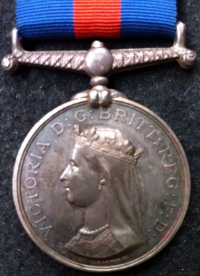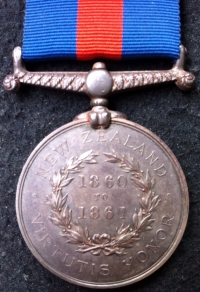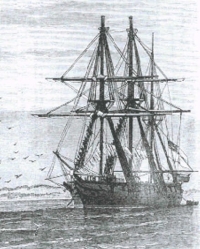







 This is the action in which LEADING SEAMAN WILLIAM ODGERS won the First VICTORIA CROSS to be awarded for service in New Zealand. He was the first man to enter the fort and haul down the Maori flag.
The Niger was sent to New Zealand to help support the settlers who were fighting the Maori in land disputes called the Taranaki wars that frequently got bloody.
The most noteworthy of these, in which John Jones may have been involved is called the “Battle of Waireka" on 28 March, 1860.
The Niger was present and bombarded a Maori-built fort which was threatening access to settlements beyond it, but this was insufficient to dislodge the defenders. The captain H.M.S. Niger, Captain Cracroft, assembled and led a large shore party which “stripped the ship of every man it was possible to spare” who even brought a cannon with them.
It is therefore highly likely that John Jones was part of the shore party.
At the fortification, Captain Cracroft announced that he would give Ten Pounds in gold to whoever would take down the enemy flag, and this was eventually accomplished by a crewman from the Niger.
The sailor, Leading Seaman William Odgers, was awarded a Victoria Cross for his action, making the Battle of Waireka the first incident of the New Zealand wars in which a V.C. was earned.
[CITATION]
"On the 28th of March,1860, at Omata, William Odgers displayed conspicuous gallantry at the Storming of a Pah during operations against Rebel Natives in New Zealand; having been the first to enter it under a heavy fire, and having assisted in hauling down the enemy's colours."
There were specific instructions accompanying the medal nominations indicating that simply having been in H.M.S. Niger while the bombardment was taking place would not put you onto the medal nomination list (see www.newzealandmedals.com)
The Niger spent some time in the area, landing additional shore parties when needed. Many of these involved fierce fighting with a number of casualties among the Niger personnel . A summary of this phase of the war is given in “HMS Niger and the Battle of Waireka.”
[THE FIRST TARANAKI WAR]
On 28 March 1860, during the First Taranaki War, a party of approximately 60 marines and bluejackets under the command of Captain Peter Cracroft landed at Waireka as reinforcements in the engagement that was taking place there. After reaching the Omata stockade near dusk, they proceeded to storm the by now lightly defended Kaipopo Pa, Coxwain William Odgers broke through the palisades and pulled down the Māori ensigns flying there, and received the first Victoria Cross of the New Zealand wars as a result
This is the action in which LEADING SEAMAN WILLIAM ODGERS won the First VICTORIA CROSS to be awarded for service in New Zealand. He was the first man to enter the fort and haul down the Maori flag.
The Niger was sent to New Zealand to help support the settlers who were fighting the Maori in land disputes called the Taranaki wars that frequently got bloody.
The most noteworthy of these, in which John Jones may have been involved is called the “Battle of Waireka" on 28 March, 1860.
The Niger was present and bombarded a Maori-built fort which was threatening access to settlements beyond it, but this was insufficient to dislodge the defenders. The captain H.M.S. Niger, Captain Cracroft, assembled and led a large shore party which “stripped the ship of every man it was possible to spare” who even brought a cannon with them.
It is therefore highly likely that John Jones was part of the shore party.
At the fortification, Captain Cracroft announced that he would give Ten Pounds in gold to whoever would take down the enemy flag, and this was eventually accomplished by a crewman from the Niger.
The sailor, Leading Seaman William Odgers, was awarded a Victoria Cross for his action, making the Battle of Waireka the first incident of the New Zealand wars in which a V.C. was earned.
[CITATION]
"On the 28th of March,1860, at Omata, William Odgers displayed conspicuous gallantry at the Storming of a Pah during operations against Rebel Natives in New Zealand; having been the first to enter it under a heavy fire, and having assisted in hauling down the enemy's colours."
There were specific instructions accompanying the medal nominations indicating that simply having been in H.M.S. Niger while the bombardment was taking place would not put you onto the medal nomination list (see www.newzealandmedals.com)
The Niger spent some time in the area, landing additional shore parties when needed. Many of these involved fierce fighting with a number of casualties among the Niger personnel . A summary of this phase of the war is given in “HMS Niger and the Battle of Waireka.”
[THE FIRST TARANAKI WAR]
On 28 March 1860, during the First Taranaki War, a party of approximately 60 marines and bluejackets under the command of Captain Peter Cracroft landed at Waireka as reinforcements in the engagement that was taking place there. After reaching the Omata stockade near dusk, they proceeded to storm the by now lightly defended Kaipopo Pa, Coxwain William Odgers broke through the palisades and pulled down the Māori ensigns flying there, and received the first Victoria Cross of the New Zealand wars as a result
 On 30 March 1860, HMS Niger shelled Māori positions near Warea.
Her crew also participated during the storming of the Omata stockade.
She left the Australia Station in late 1860. She then served in the North America and West Indies Station.
Later in 1860 the detachment of Marines was stationed as a garrison at Fort Niger, a hill overlooking the New Plymouth suburb of East End. The hill is a reserve today.
Controversially this action was labelled a "fictional triumph" and a myth by New Zealand revisionist historian James Belich. However military historian Nigel Prickett asserts the action was a catastrophic defeat for southern insurgents who lost their overall chiefs and most of their lesser chiefs at Kaipopo Pa.
The Medal Roll clearly confirms that N.Z. 1860-61 medals were only issued to ‘Naval Brigade Only’ and to the survivors who actually landed and engaged the enemy at Waieka Pa.
Further stating: ‘Not granted for service in ship when she fired’.
On 30 March 1860, HMS Niger shelled Māori positions near Warea.
Her crew also participated during the storming of the Omata stockade.
She left the Australia Station in late 1860. She then served in the North America and West Indies Station.
Later in 1860 the detachment of Marines was stationed as a garrison at Fort Niger, a hill overlooking the New Plymouth suburb of East End. The hill is a reserve today.
Controversially this action was labelled a "fictional triumph" and a myth by New Zealand revisionist historian James Belich. However military historian Nigel Prickett asserts the action was a catastrophic defeat for southern insurgents who lost their overall chiefs and most of their lesser chiefs at Kaipopo Pa.
The Medal Roll clearly confirms that N.Z. 1860-61 medals were only issued to ‘Naval Brigade Only’ and to the survivors who actually landed and engaged the enemy at Waieka Pa.
Further stating: ‘Not granted for service in ship when she fired’.

 THE MEDAL IS WITHOUT MUCH DOUBT THE FINEST SURVIVING EXAMPLE FROM THIS SHIP & ACTION AND IS A UNIQUE SURVIVOR IN SUPERB & "TOTALY GEM MINT STATE" CONDITION. The medal has flashy Prooflike fields under a superb and naturally time developed purple & grey tone.
A wonderful and very rare Royal Navy, New Zealand medal to a VICTORIA CROSS action on a length of original Victorian silk & cotton ribbon.This one of only 66 medals for this action of which only about 32 are known to survive. Totally Stunning !
£2250 . Part-Exchanges Welcome.
THE MEDAL IS WITHOUT MUCH DOUBT THE FINEST SURVIVING EXAMPLE FROM THIS SHIP & ACTION AND IS A UNIQUE SURVIVOR IN SUPERB & "TOTALY GEM MINT STATE" CONDITION. The medal has flashy Prooflike fields under a superb and naturally time developed purple & grey tone.
A wonderful and very rare Royal Navy, New Zealand medal to a VICTORIA CROSS action on a length of original Victorian silk & cotton ribbon.This one of only 66 medals for this action of which only about 32 are known to survive. Totally Stunning !
£2250 . Part-Exchanges Welcome.